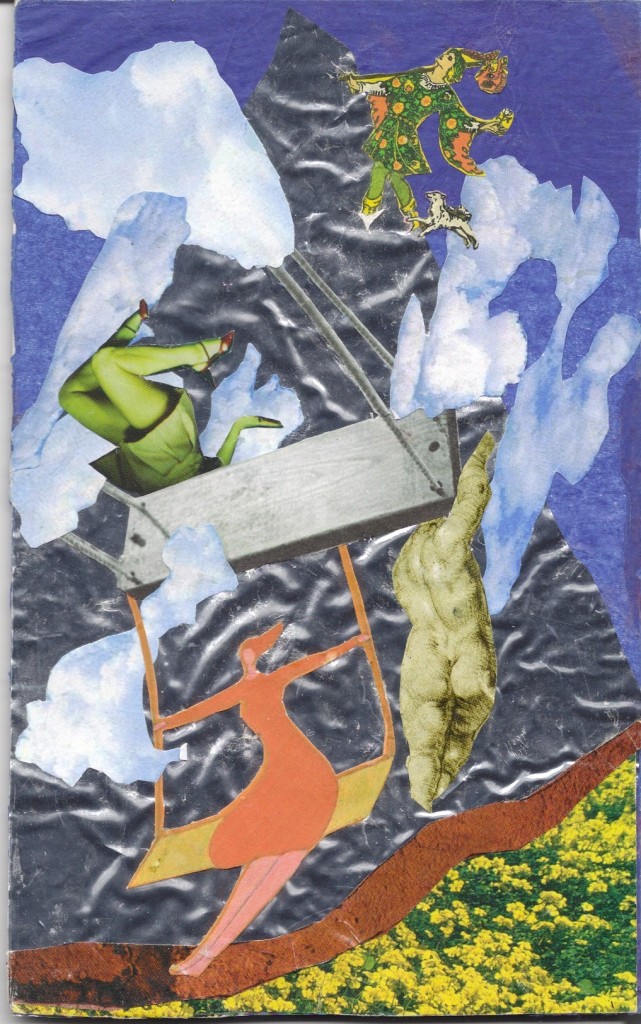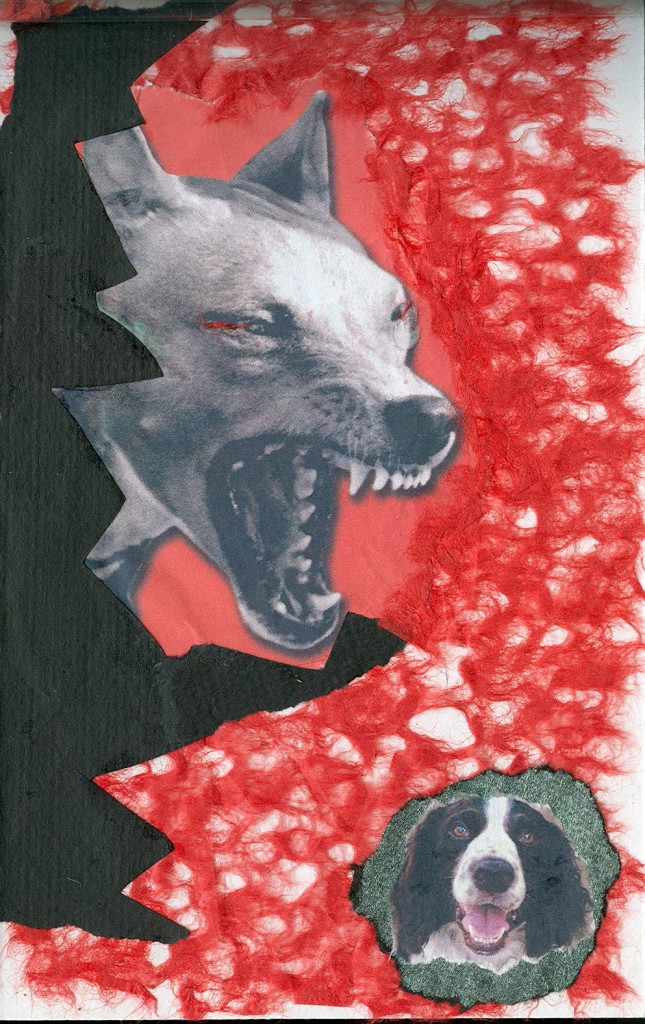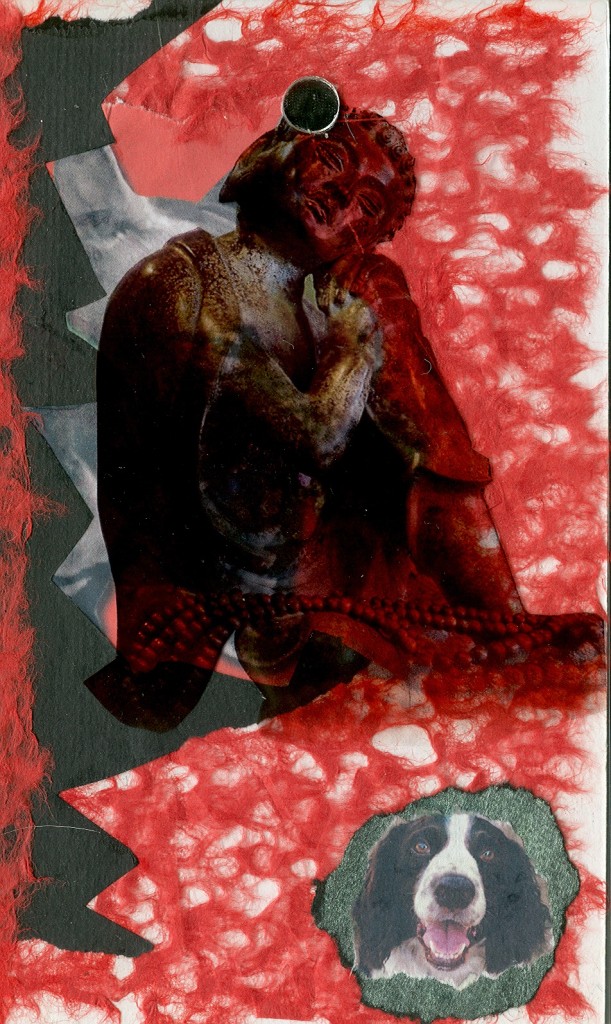Dreams are shimmering pathways to deep psyche and to soul. In the language of nuance, metaphor, and pun, they speak to us of visions and callings from unknown places. Dreams hold the power to bring awe, to surprise, to delight, to terrify, and to heal us. A practice of dream work uncovers the “medicines” inherent in our deepest self-knowing. The expressive arts hold this same power and can enhance our dream work in many ways.
There is a great resonance between the practice of dream work and collage. Collage refers to the process of gluing together of papers, cut-out images, photos or other materials to compose a new picture. When working with dreams, it is often useful to engage the collage materials intuitively to allow images to “step forward.” In this way, we are delving into what we already know about a dream, and we are opening to what wants to be revealed. The process of collage invites discovery. In effect, it serves as a visual journaling technique. Combined with a written journal, collage can deepen and animate the essential nature of a dream.
In this context, each collage is a waking dream, and each of the images it contains is a dream figure. As we sit with our images and dialogue with them, we explore them as we might explore a dream. In the same way that our dreams provide guidance and inspiration, our collaged figures and images carry this same potential.
I do not approach dreams as something to be “analyzed,” but as “soul-visitors” from the intuitive world of the unconscious, seeking my attention for the deeper purpose of knowing myself more fully. I approach my collages in exactly this same way. As an example, some years ago I was in a quandary regarding a decision that would greatly impact a close friend of mine, and I asked for help from a dream. The following dream visited that evening:
I am sitting with my friend on a swing hanging from two clouds in a blue, blue sky. I say to her: ‘If you don’t step out on the edge now to take the leap, you will never know what might happen.”
This dream carried a clear message to make the decision that was outside of my more predictable pattern. This was very much a “leap of faith,” and it proved to be the correct choice. The dream inspired the following collage and journaling.
I am one who leaps. Come, come to the edge.
Leap! Yes: body first, trust body, trust body.
Then mold features, love face into being.
Love: swing between layers, touching stars, touching earth.
Landing, feet find path, find the way, home.
Often, I will explore a dream through the process of creating several collages that help to reveal its core energies. The following dream is a poignant illustration of how a source of light and healing often accompanies a shadow image.
I am at a gathering. An angry dog is out of control, nipping at my feet and growling. I am unable to control him. A beautiful woman enters. She is soft and beautiful, and she carries a strong presence of loving containment. The dog becomes subdued immediately, lies happily at her feet.
While tending the dream, I created a collage that superimposes the image of a soft feminine presence on transparency over the initial image of an angry dog. The transparency—glued only at the top—can be lifted up to reveal the original image underneath.
The first collage copied above expresses the energetic quality of the angry dog. The dog at the bottom is a photograph of my own beloved Springer Spaniel. In the second collage, the feminine presence covers only the angry dog, while the Springer’s image remains. In this way, I am honoring both shadow and light, reflecting on their separate and simultaneous expressions.
After completing the collages, I wrote:
Uncontained and unsoothed,
I redden with rage— teeth bared
and growl always worse than my bite.
But how are you to know?
How am I to know, until,
remembering Her,
I feed on pure presence:
boundless love reflected.
Below, I offer several suggestions for how to incorporate use the collage process to deepen your dream work. Mostly, I work in a relatively small format, and often make several collages for particularly potent dreams.
- Render a single image in a dream, perhaps the most compelling image, as a way to move into a deeper relationship with it. For example, if a landscape is the most compelling part of a dream, you might want to only collage that aspect; then let it speak to you by journaling directly from the image itself.
- A singe word, phrase, or even a poem might be all that remains of a dream. Consider making a collage that these words evoke. You might choose to write a poem to accompany the image.
- At times, all you recall and carry into your day is the FEELING elicited by a dream, with no details. Make a collage for these subtle dream energies/images to clarify their meaning. If the feeling evokes a color, it can be useful to work with only this color in order to delve more deeply into the subtleties of the affect.
- Sometimes a dream image “asks” to be drawn, painted, or collaged to give it visual representation. You might begin with the literal image, and that may be sufficient. Or, perhaps, the literal image might morph into something else. Let it tell you what wants to happen.
- If you have a dream that “makes no sense,” it can be very useful to make a collage of the disparate elements in it, laying them out in the same collage, and seeing how they “want” to organize themselves.
- Sometimes a dream makes enormous sense. You might call it “an important dream” or “a big one.” As you step into the meaning of such a dream, you might find yourself needing to make more than one collage. As the dream unfolds over time, you might return to it and make a sequence of collages representing its teachings.
- Nightmares are powerful manifestations of shadow material. The nightmare itself is not the problem; it is our fear and unwillingness to meet the figures and energies it contains. Make a collage, and work with it as you would with any shadow material. As you process the material, make a companion “light” collage to represent the light that accompanies any shadow material.
- Recurring dreams are served wonderfully by making cards for the figures, feelings, landscapes, and particular details that visit again and again. Learn about these energies by making one or several collages to represent them.
- Journaling enhances all dream-inspired collages. Even if you do not collage your dream, entering into dialogue with your dream energies through this practice will deepen your understanding and insight.
To summarize, in the same way that we engage the depth of our collaged images, a dream unfolds when we step out of our own way. Making a collage (or collages) for our dreams externalizes the insight that we have derived and grounds it into our consciousness. Collaging will often give us access to material that initially seemed to be inaccessible. Because dreams are often subtle and may seem unknowable, the marriage of dream work with this expressive process is very potent, indeed. Together they help us reveal and receive transformative gifts from our night visitors.
As Wendell Berry says in To Know the Dark:
To go in the dark with a light is to know the light.
To know the dark, go dark. Go without sight,
and find that the dark, too, blooms and sings,
and is traveled by dark feet and dark wings.
Source: Nancy Weiss, LCSW, BCD
nancyweiss@gmail.com
Please contact Nancy for permission to reprint this article, or any parts of it.



